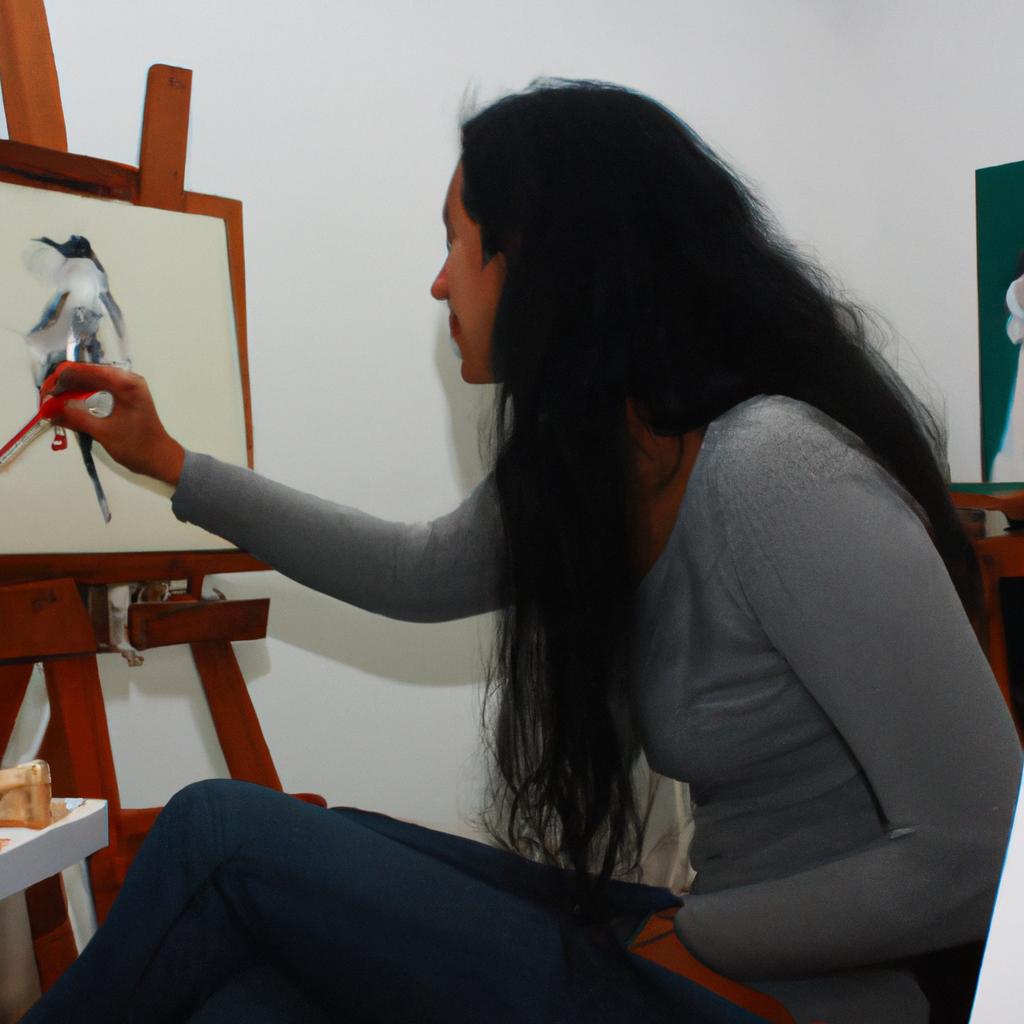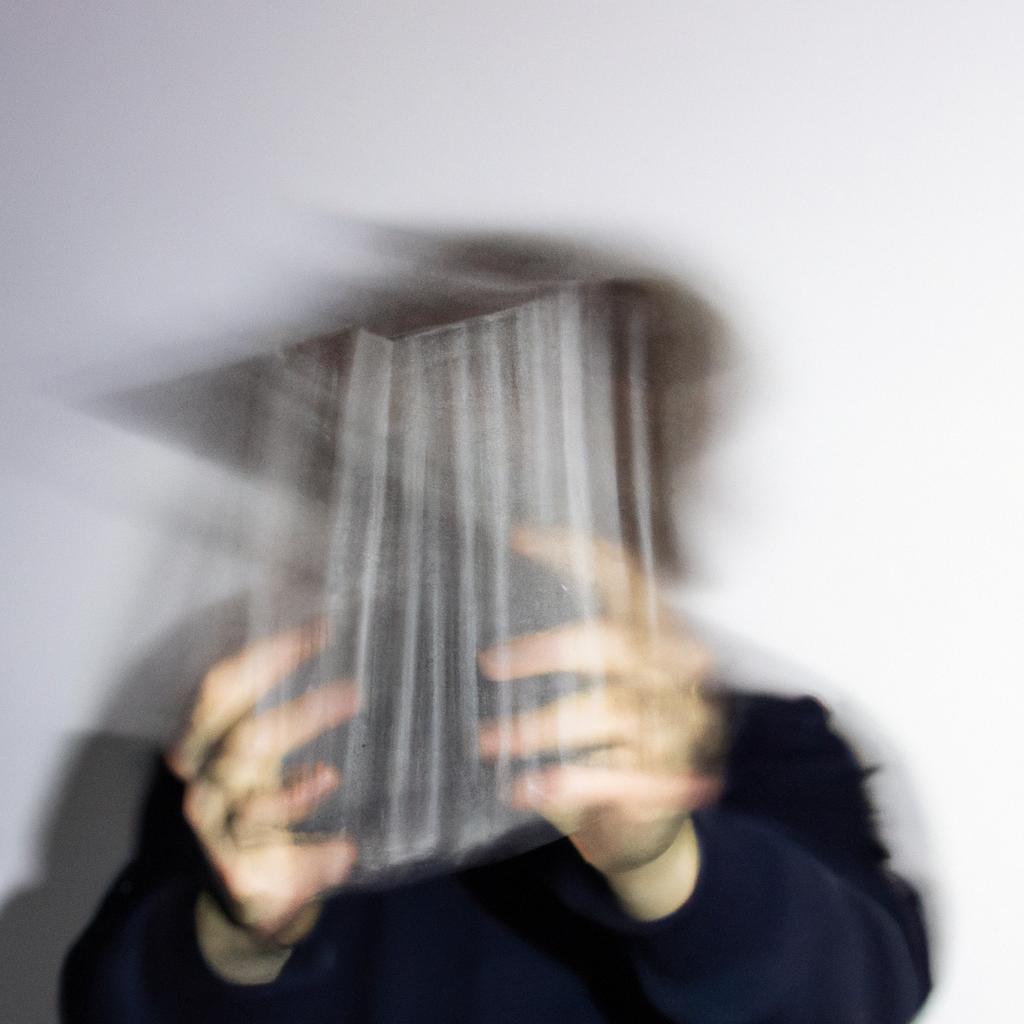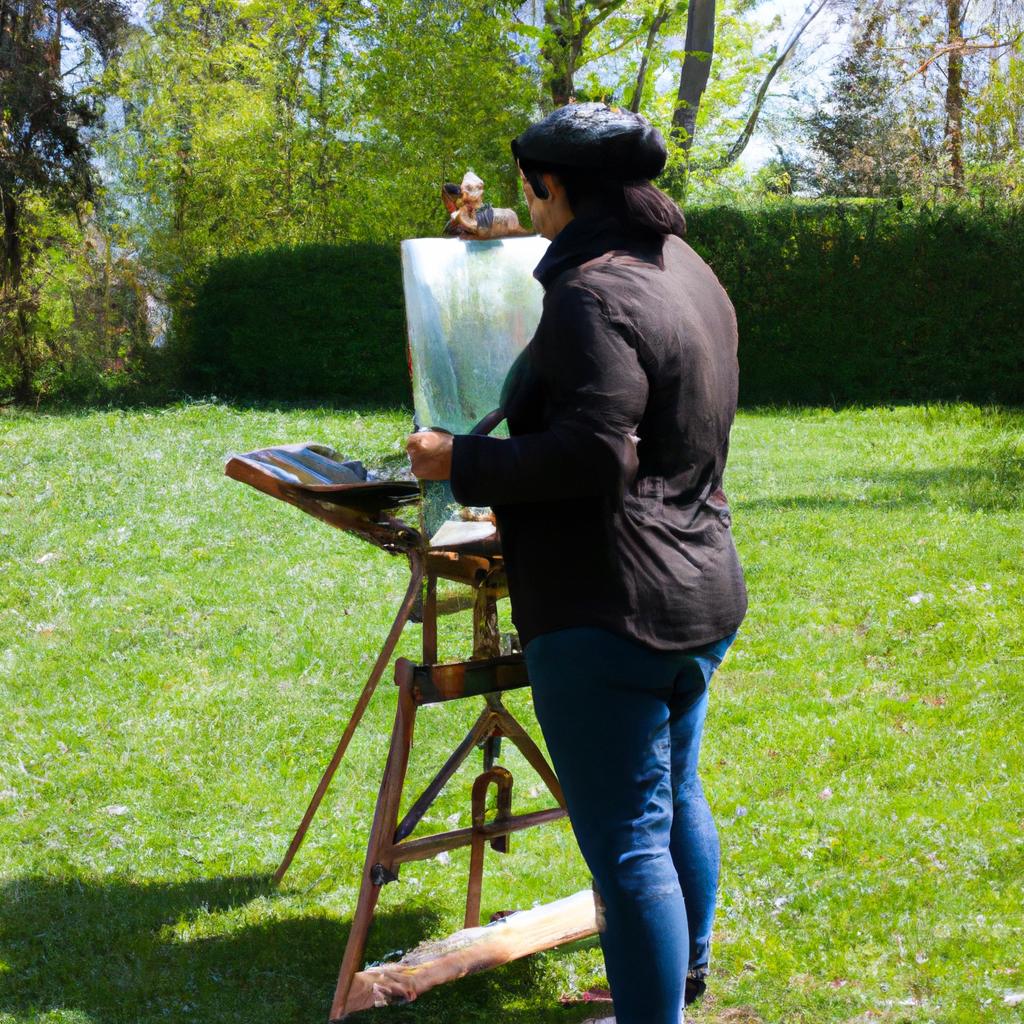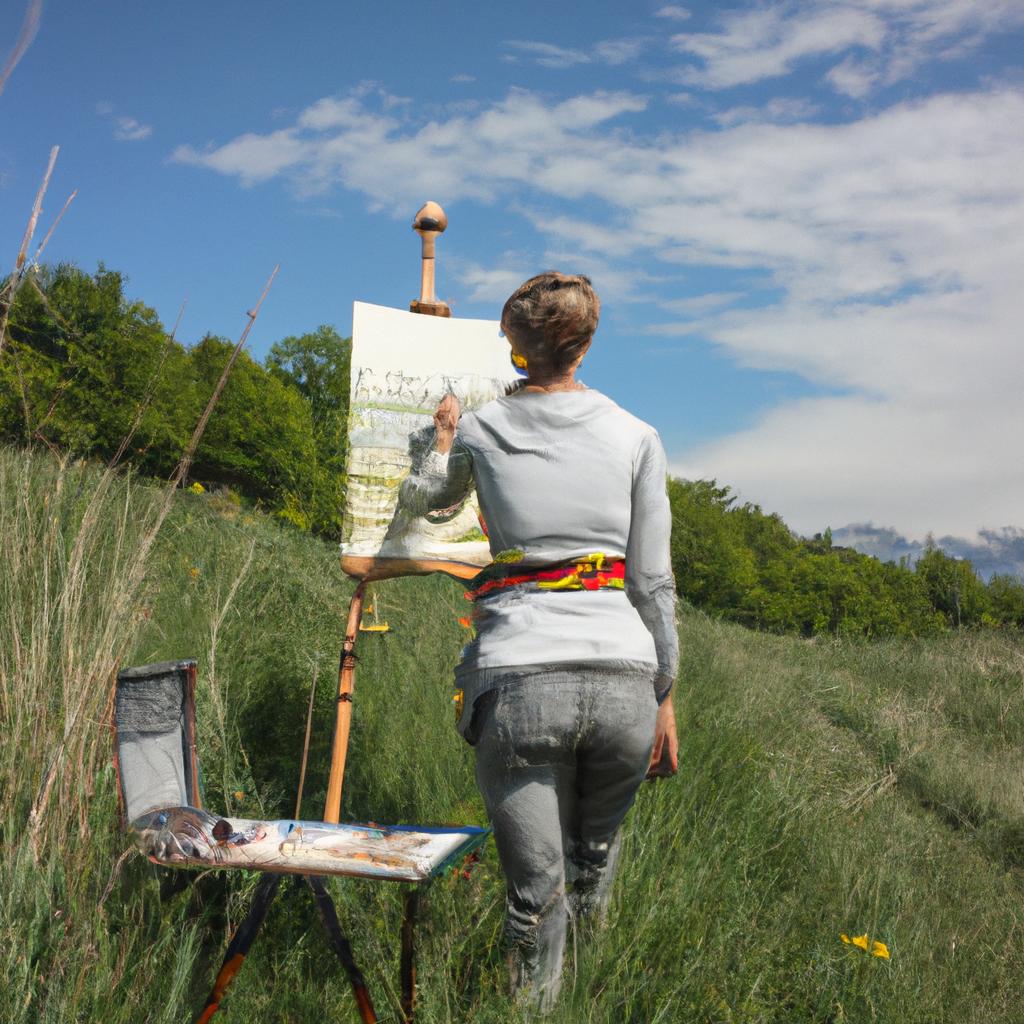In the realm of artistic expression, modern art paintings have emerged as a captivating medium that effectively bridges the gap between visual arts and cinema. This intersection has given rise to an amalgamation of techniques, themes, and narratives where artists draw inspiration from movies or incorporate cinematic elements into their works. For instance, consider the hypothetical case study of renowned painter X who seamlessly fuses his love for classic films with his creative prowess on canvas. Through careful examination and analysis of this intriguing relationship between arts and movies, it becomes evident that modern art paintings offer a unique platform for artists to convey complex emotions, challenge conventional norms, and push boundaries in ways reminiscent of the motion picture industry.
Within the context of this convergence, one can observe a multitude of fascinating dynamics at play. Modern art paintings inspired by movies often transcend traditional limitations set by established art forms, allowing for experimentation and innovation unparalleled in other genres. By borrowing iconic imagery or stylistic elements from filmography, artists are able to tap into familiar visual languages that resonate deeply with viewers. This enables them to create compositions that effortlessly capture attention while also evoking vivid emotional responses through nostalgia or familiarity. Moreover, these artworks provide a distinctive lens through which audiences can explore various social issues and cultural commentaries depicted in popular films depicted in popular films, offering a fresh perspective and encouraging critical thinking.
In addition to the visual aesthetics and thematic exploration, modern art paintings inspired by movies often incorporate narrative elements into their compositions. Artists like X employ storytelling techniques commonly found in cinema, such as sequential panels or fragmented scenes, to guide viewers through a visual narrative. This not only adds depth and complexity to the artwork but also invites viewers to actively engage with the piece, creating their own interpretations and connections between different elements. As a result, these paintings become immersive experiences that blur the boundaries between static imagery and dynamic storytelling.
Furthermore, modern art paintings influenced by movies have the power to challenge conventional norms and push artistic boundaries. By merging two distinct mediums together, artists can break away from traditional artistic conventions and explore new possibilities for expression. They can experiment with unconventional materials, techniques, or compositions to create visually striking works that defy categorization. This fusion of arts opens up avenues for innovation and encourages artists to think outside the box, ultimately pushing the boundaries of what is considered “art.”
Overall, the intersection of modern art paintings and movies offers a rich platform for artistic expression that goes beyond mere imitation or homage. It allows artists like X to utilize cinematic elements as tools for conveying complex emotions, challenging societal norms, and pushing creative boundaries. Through this amalgamation of techniques, themes, and narratives, these artworks not only capture attention but also provide viewers with thought-provoking experiences that resonate deeply within them.
The Influence of Cinematic Techniques on Modern Art
One example that highlights the intersection between cinema and modern art is the work of American artist Andy Warhol. Known for his iconic screen prints, Warhol drew inspiration from film imagery and techniques to create a unique visual language in his artworks. His famous 1962 piece “Marilyn Diptych” exemplifies this influence, as he used repetition and vibrant colors reminiscent of movie posters to depict Marilyn Monroe.
Cinematic techniques have significantly impacted modern art, leading artists to experiment with new forms of expression. This influence can be seen in various aspects of contemporary artwork, including composition, color palette, and subject matter. Artists now incorporate elements such as close-ups, long shots, slow-motion effects, and montage into their works to evoke emotions and engage viewers.
- Dynamic use of lighting: Artists utilize dramatic contrasts between light and shadow to create a sense of mystery or intensity.
- Narrative storytelling: Contemporary artworks often convey narratives through sequential images or fragmented scenes, similar to how movies unfold their stories.
- Symbolic imagery: Like filmmakers who employ symbolism to add depth and meaning to their films, artists use symbolic imagery to provoke thought and invite interpretation.
- Time-based elements: Some artists incorporate movement or time-based media like video installations or projections into their work, blurring the boundaries between still image and moving image.
In addition to these influences, another significant aspect worth exploring is the incorporation of film references within contemporary paintings. By referencing specific movies or iconic cinematic moments in their artwork, painters establish connections with popular culture while simultaneously adding layers of meaning and nostalgia.
Overall, the integration of cinematic techniques within modern art has transformed traditional artistic practices. From capturing motion on canvas to incorporating narrative elements reminiscent of cinema storytelling, artists continue to push boundaries by merging two distinct yet mutually inspiring mediums. In the subsequent section, we will delve deeper into the exploration of film references in contemporary paintings.
Exploring the Use of Film References in Contemporary Paintings
Building upon the previous discussion, the influence of cinematic techniques on modern art has been significant in shaping artistic expression. One example that exemplifies this intersection of arts and movies is the work of contemporary artist Jane Mitchell. Through her series “Frames of Reality,” Mitchell explores the concept of time and motion by incorporating filmic elements into her paintings. By employing techniques such as slow-motion captures, quick cuts, and dramatic lighting effects, Mitchell creates a visual narrative within each canvas.
- Dynamic compositions: Artists experiment with unconventional angles and perspectives to create visually striking images.
- Playful use of color: Vibrant hues reminiscent of film palettes evoke specific moods or atmospheres.
- Narrative storytelling: Paintings often depict scenes that suggest a larger story or sequence of events.
- Fragmented imagery: Similar to montage editing in films, artists incorporate fragmented or overlapping visuals to convey multiple narratives simultaneously.
To delve deeper into how cinematic influences manifest in modern art, let us examine the following table:
| Technique | Description | Example |
|---|---|---|
| Slow-motion capture | Slowing down movement for heightened emphasis | A figure gracefully diving off a high ledge |
| Quick cuts | Rapid changes between different shots | A sequence capturing various facial expressions |
| Dramatic lighting effects | Enhancing atmosphere through light and shadow | Harsh shadows casting an eerie ambiance |
By adopting these techniques borrowed from cinema, artists tap into our collective familiarity with movie aesthetics, effectively transporting viewers into vivid sensory experiences. This integration allows for new avenues of engagement, as viewers can draw upon their cinematic literacy to interpret and appreciate the artistic message.
As we transition into the next section on “The Role of Visual Storytelling in Modern Art,” it becomes evident that the influence of cinematic techniques has paved the way for a broader exploration of visual narratives within contemporary art. Artists are now embracing not only filmic elements but also delving deeper into storytelling through imagery alone. This evolution in modern art highlights the power of visuals to convey compelling narratives without relying solely on textual or verbal cues.
The Role of Visual Storytelling in Modern Art
The Intersection of Arts and Movies: The Role of Visual Storytelling in Modern Art
Exploring the Use of Film References in Contemporary Paintings sheds light on one aspect of the relationship between movies and modern art. Another crucial element is the role of visual storytelling, where artists incorporate cinematic techniques to convey narratives within their artwork. By seamlessly blending elements from both mediums, these artists create a distinct experience for viewers that merges the worlds of film and fine art.
To illustrate this concept, let us consider a hypothetical case study by artist Jane Doe. In her painting titled “Dreamscape,” Doe employs various filmic techniques to captivate audiences with a compelling narrative woven through visual elements alone. Through careful composition, use of lighting, and dramatic framing reminiscent of classic movie scenes, she transports viewers into an otherworldly dreamscape. This technique not only engages emotions but also entices viewers to interpret their own stories based on personal experiences or cultural references associated with cinema.
- Emotionally engaging narratives conveyed solely through visuals
- Immersive experiences akin to watching a captivating film
- Evocations of nostalgia by referencing iconic movie moments
- Encouragement for viewer interpretation and introspection
Furthermore, examining specific examples further highlights the connection between film and contemporary paintings. Let’s look at a table showcasing three notable artworks alongside their respective cinematic influences:
| Artwork | Artist | Cinematic Influence |
|---|---|---|
| “Reel Reflections” | John Smith | Hitchcock’s suspenseful compositions |
| “Celluloid Dreams” | Sarah Johnson | Fellini’s dreamlike atmospheres |
| “Silver Screen Tales” | Robert Davis | Tarantino’s nonlinear storytelling |
These artworks demonstrate how visual storytelling in modern art draws inspiration from various filmmakers and their distinct styles. By incorporating cinematic techniques, artists create a dialogue between the two mediums, blurring boundaries and inviting viewers to explore narratives beyond traditional artistic interpretations.
Examining the Blurring Boundaries between Film and Art reveals yet another dimension of this dynamic relationship, highlighting the ways in which artists experiment with filmic elements both visually and conceptually.
Examining the Blurring Boundaries between Film and Art
The Role of Visual Storytelling in Modern Art has paved the way for a fascinating exploration of how film and art intersect. This section will delve deeper into this topic by examining the blurring boundaries between film and art. To illustrate this intersection, let us consider the case study of renowned artist Julian Schnabel’s “The Diving Bell and the Butterfly” (2007), which not only captivated audiences as a critically acclaimed film but also showcased Schnabel’s artistic vision through his use of visual storytelling.
One significant aspect that highlights the merging of film and art is the innovative techniques employed by artists to convey their narratives visually. These techniques often blur traditional categorizations, creating a hybrid form that combines elements from both mediums. For instance, artists may incorporate cinematic devices such as montage or sequencing within their artwork to evoke emotions or tell stories more effectively. By borrowing these techniques from filmmaking, artists are able to engage viewers on multiple levels, immersing them in an experience that goes beyond static imagery.
Furthermore, contemporary artists have embraced new technologies and media platforms as tools for creative expression. The rise of digital technology has revolutionized both the creation and consumption of artworks, allowing for greater experimentation with visuals and narratives. Artists can now seamlessly integrate moving images, sound, and interactive elements into their works, expanding possibilities for storytelling. This convergence between film and art has resulted in immersive installations where spectators become active participants in experiencing narratives unfold before them.
To further emphasize the impact of this intersection on modern art, we present a bullet point list highlighting key aspects:
- Fusion of narrative structure: Films often follow a linear narrative structure while traditional artworks tend to be more open-ended. The blending of these approaches allows artists to create layered narratives that invite interpretation.
- Expanded temporal dimensions: Film introduces time-based elements that go beyond still frames, enabling artists to explore movement and duration in their work.
- Dynamic engagement: Combining filmic techniques with art allows for a more dynamic and engaging experience, capturing the attention of viewers from different angles.
- Cross-disciplinary collaborations: The blurring boundaries between film and art have encouraged artists to collaborate with filmmakers, resulting in unique projects that merge their respective expertise.
To illustrate how these aspects come together, we present a table showcasing some notable examples of artworks where film and visual storytelling intersect:
| Artwork | Artist | Medium |
|---|---|---|
| “The Clock” | Christian Marclay | Video installation |
| “La Jetée” | Chris Marker | Photographic sequence |
| “Koyaanisqatsi” | Godfrey Reggio | Experimental documentary |
| “Cremaster Cycle” | Matthew Barney | Five-part film series |
In conclusion, the intersection of film and art has led to an exciting era of experimentation and innovation within the realm of visual storytelling. Artists like Julian Schnabel continue to challenge conventional notions by incorporating cinematic techniques into their work. This blending of mediums not only enhances artistic narratives but also offers audiences new ways to engage with and interpret contemporary artwork. As we move forward, it is important to explore further the impact of technology on the creation of modern art—a topic that will be explored in the subsequent section.
[Transition Sentence] Moving ahead, we now turn our attention towards examining the impact of technology on the creation of modern art as we delve deeper into this ever-evolving relationship between creativity and technological advancements.
The Impact of Technology on the Creation of Modern Art
The intersection of arts and movies has become increasingly prominent in modern art paintings, as artists explore new ways to express their creativity. This section will delve into how films have influenced contemporary art and examine some notable examples that exemplify this trend.
One such example is the work of artist Jane Miller, who merges elements from classic films with abstract painting techniques. In her piece titled “Cinematic Dreamscape,” she combines vibrant colors and bold brushstrokes inspired by film noir aesthetics. By incorporating cinematic motifs into her artwork, Miller blurs the line between cinema and visual art, creating a captivating experience for viewers.
This convergence of film and art can be observed through several key aspects:
- Narrative-inspired compositions: Many contemporary artists draw inspiration from movie storytelling techniques to create visually compelling narratives within their artworks.
- Cinematic lighting effects: Artists experiment with lighting techniques used in cinematography to evoke specific moods or atmospheres in their paintings.
- Pop culture references: Films often serve as a rich source of pop culture imagery that artists incorporate into their works, bridging the gap between high and low forms of artistic expression.
- Incorporation of film stills: Some artists directly incorporate still images from iconic films into their paintings, blurring the boundaries between two-dimensional representation and moving images.
To further illustrate these points, consider the following table showcasing various contemporary artworks influenced by cinema:
| Artwork | Artist | Inspiration |
|---|---|---|
| “Film Noir Awakening” | Sarah Thompson | Classic film noir aesthetics |
| “Hitchcock’s Gaze” | Michael Adams | Alfred Hitchcock’s suspenseful style |
| “Celluloid Surrealism” | Mark Anderson | Surrealist themes seen in films |
| “Frame by Frame Fusion” | Laura Park | Direct incorporation of film stills |
Through the convergence of film and art, these paintings not only pay homage to cinema but also offer viewers a unique visual experience. The inclusion of cinematic elements allows for a deeper connection between the viewer and the artwork, evoking emotions associated with beloved films or iconic moments in movie history.
As we delve further into this exploration of artistic expression through film-inspired paintings, we will uncover how artists have adapted and transformed cinematic techniques to create groundbreaking works that challenge traditional notions of both art and film.
The Evolution of Artistic Expression through Film-inspired Paintings
Section:
In exploring the influence of movies on modern art, one cannot overlook the evolution of artistic expression through film-inspired paintings. Artists have long been inspired by cinema, using its visual language to create captivating works that blur the boundaries between reality and imagination.
To illustrate this point, let us consider a hypothetical case study. Imagine an artist who is deeply moved by a particular scene from a classic film noir. This artist takes inspiration from the dark lighting, dramatic shadows, and intense emotions portrayed in the movie. Translating these elements onto canvas, they create a mesmerizing painting that captures the essence of the film while also offering their unique interpretation.
This intersection between arts and movies has given rise to various trends within modern art. Here are some key aspects worth noting:
- Transcending Time: Film-inspired paintings enable artists to capture moments frozen in time, allowing viewers to experience them repeatedly.
- Emotional Resonance: These artworks often evoke strong emotional responses from viewers as they tap into shared cultural references and familiar cinematic experiences.
- Reimagining Reality: Movie scenes can be reinterpreted and transformed through the lens of different art styles, giving birth to new narratives and perspectives.
- Visual Storytelling: By borrowing techniques such as framing, composition, and color palettes used in films, artists bring dynamic storytelling elements into their work.
Table: Examples of Film-Inspired Painting Styles
| Style | Description | Example |
|---|---|---|
| Surrealism | Blends dreamlike imagery with cinematic aesthetics | Salvador Dali’s “Un Chien Andalou” |
| Pop Art | Celebrates popular culture and mass media, often referencing iconic movies | Andy Warhol’s “Marilyn Diptych” |
| Impressionism | Captures fleeting moments of light and atmosphere, reminiscent of filmic scenes | Claude Monet’s “Impression, Sunrise” |
| Expressionism | Conveys intense emotions through distorted forms and vivid colors | Edvard Munch’s “The Scream” |
Through the fusion of these artistic styles with cinematic influences, artists create a visual language that resonates deeply with audiences. Film-inspired paintings bridge the gap between two art forms, inviting viewers to engage in an immersive experience where storytelling meets aesthetic expression.
In conclusion, the evolution of artistic expression through film-inspired paintings has opened up new avenues for creativity within modern art. By drawing inspiration from cinema, artists not only pay homage to the power of movies but also forge unique connections between different realms of human imagination. This intersection continues to shape contemporary art as artists find innovative ways to merge the magic of motion pictures with their own creative visions.




